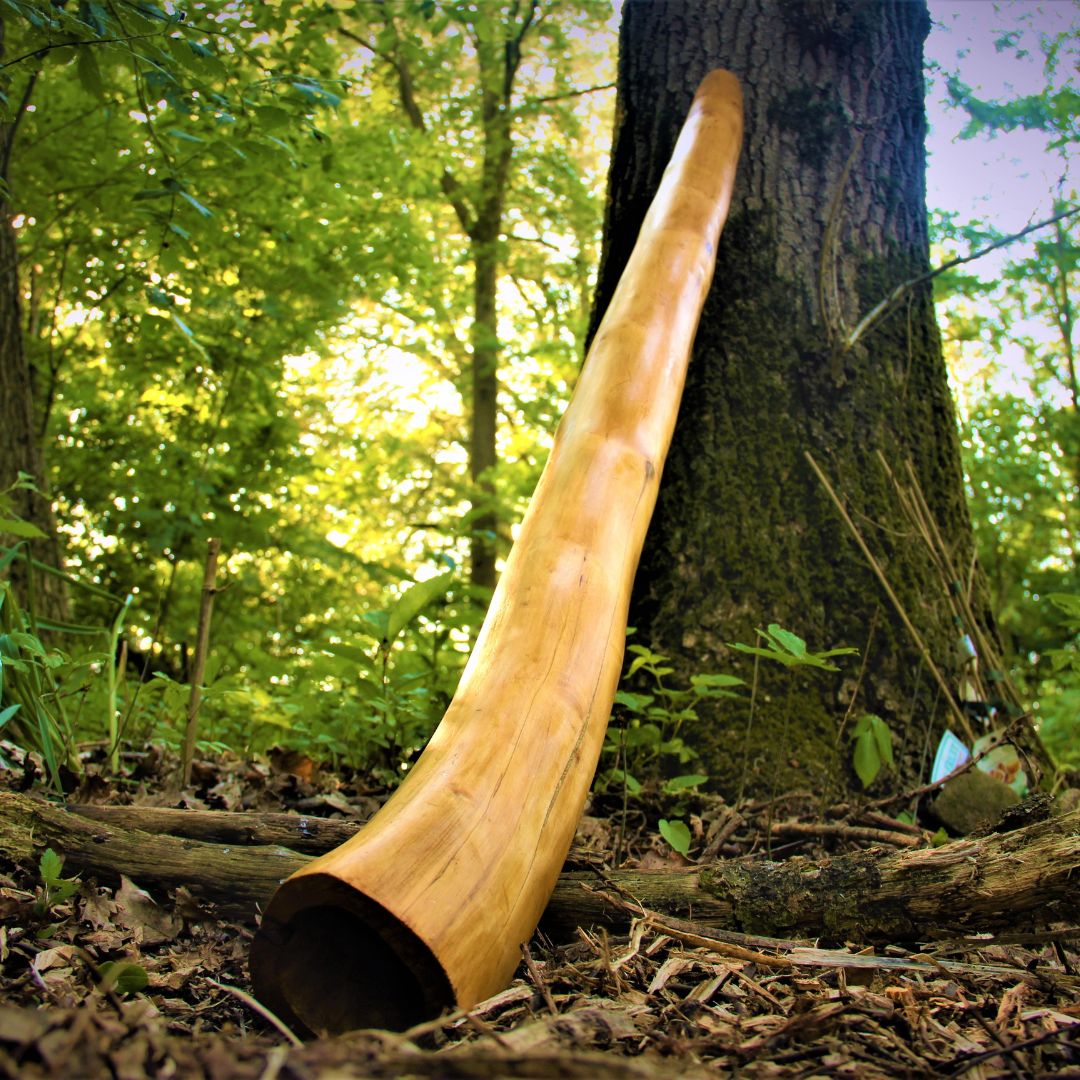Originating from uses in Australian Aboriginal ceremonies, the didgeridoo has increasingly gained global recognition and is played by musicians around the world.
What is a didgeridoo?
A wind instrument, the didgeridoo is recognizable by its conical or cylindrical shape and can measure between 3 and 10 feet long. The pitch is determined by the length of the instrument, and sounds are changed by the player’s technique. Circular breathing contributes to the drone the didgeridoo is often associated with. Vocalizations and overtone playing by changing air pressure are also used. (The Editors of Encyclopaedia Britannica, 2023)
Sound is produced by the player vibrating their lips against the mouthpiece. Traditionally, the didgeridoo is made from hardwoods like eucalyptus that had been hollowed out by termites. Indigenous craftspeople identify suitable eucalyptus trees by the resonance of their trunks when struck, before cutting, cleaning, and smoothing the didgeridoo. Bamboo and synthetic materials such as PVC are now commonly used. Some players apply a ring of beeswax to the mouthpiece for more comfortable playing. (DidgeridooBreath, 2023)
Where does the name come from?
“Didgeridoo” is not a word that originates from Australian Aboriginal languages. Sources such as newspapers from the early 20th century suggest the word “didgeridoo” emerged as onomatopoeia to describe the sound produced by the instrument (Australian National University, 2017).
There are efforts to have an Australian Aboriginal word for the instrument replace “didgeridoo”. This is a challenging endeavor because there are several different names used by the Australian Aboriginal peoples. “Yidaki”, a name from the Yolngu people, is most used, though it technically refers to a specific form of the instrument innovated by the Yolngu people for ceremonies (Spirit Gallery, 2023).
Considerations when Playing the Didgeridoo
Because of its representative nature of the cultures and ways of Aboriginal peoples, the didgeridoo is an instrument meriting respect by its players. Care should be taken that playing or composing for the didgeridoo does not appropriate the culture to which this instrument is interlinked.
The Australia Council for the Arts has published protocols and case studies on demonstrating proper respect for Aboriginal cultural properties, including the rightful use of instruments and performance of music (Australia Council for the Arts, 2007). Generally, public performances should provide clear context for why a didgeridoo is being incorporated. The instrument should not be performed in a way that imitates the sacred ceremonies the didgeridoo traditionally performed a part in. Generally, public performances should provide clear context for why a didgeridoo is being incorporated.
Especially for performances intended to be representative of Aboriginal music, an indigenous player should be sought for both consultation and to perform on the didgeridoo. In some tribes, women do not play the didgeridoo, and this has led to debate in music scholarship over the balance between modern attitudes toward inclusion and abiding by the rules instituted by cultures that created the instrument (Schaefer, 2019).
Playing original works or compositions not appropriated from Aboriginal peoples on the didgeridoo for personal recreation is acceptable. Be mindful of the kind of didgeridoo you play, and how you obtain it. Some manufacturers include designs on their didgeridoos that appropriate sacred Aboriginal imagery. Avoid these, and instead seek plain styling. Also opt to buy from manufacturers or sellers local to Australia who fairly compensate indigenous craftspeople or support Aboriginal peoples.
Ultimately, do not play the didgeridoo for attention. Treat playing this instrument as a privilege and acknowledge the history and cultural significance behind it.
Sources:
Australia Council for the Arts. (2007). Protocols for using First Nations Cultural and Intellectual Property in the Arts. Retrieved from Australia Council for the Arts: https://australiacouncil.gov.au/investment-and-development/protocols-and-resources/protocols-for-using-first-nations-cultural-and-intellectual-property-in-the-arts/
Australian National University. (2017, October 19). Meanings and origins of Australian words and idioms. Retrieved from Australian National Dictionary Centre: https://slll.cass.anu.edu.au/centres/andc/meanings-origins/d
DidgeridooBreath. (2023). What is a Didgeridoo? Retrieved from Didgeridoo Breath: https://www.didgeridoobreath.com/what-is-a-didgeridoo/
Schaefer, J. (2019, August 8). Earth Sounds: The Didgeridoo Stirs Controversy at the Bang on a Can Summer Festival. Retrieved from New Sounds: https://www.newsounds.org/story/earth-sounds-didgeridoo-stirs-controversy-bang-can-summer-festival/
Spirit Gallery. (2023). Yidaki. Retrieved from Spirit Gallery: https://www.spiritgallery.com.au/yidaki-information
The Editors of Encyclopaedia Britannica. (2023). didjeridu. Retrieved from Britannica: https://www.britannica.com/art/didjeridu

